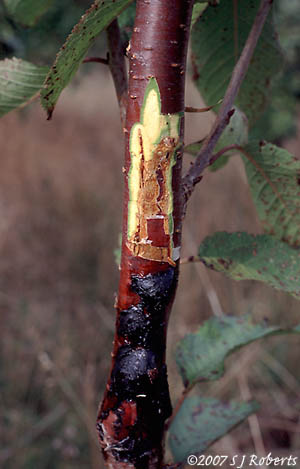rep-PCR discriminates bacterial canker races
By Steve Roberts, 08 Mar 2007
Abstract of the paper: Discrimination of Pseudomonas syringae isolates from sweet and wild cherry using rep-PCR Vicente J G & Roberts S J (2007) Eur J Plant Pathol.117: 383-392. Bacterial canker is one of the most important diseases of cherry (Prunus avium). This disease can be caused by two pathovars of Pseudomonas syringae: pv. morsprunorum and pv. syringae. Repetitive DNA polymerase chain reaction-based fingerprinting (rep-PCR) was investigated as a method to distinguish pathovars, races and isolates of P. syringae from sweet and wild cherry. After amplification of total genomic DNA from 87 isolates using the REP (repetitive extragenic palindromic), ERIC (enterobacterial repetitive intergenic consensus) and BOX primers, followed by agarose gel electrophoresis, groups of isolates showed specific patterns of PCR products. Pseudomonas syringae pv. syringae isolates were highly variable. The differences amongst the fingerprints of P. syringae pv. morsprunorum race 1 isolates were small. The patterns of P. syringae pv. morsprunorum race 2 isolates were also very uniform, with one exception, and distinct from the race 1 isolates. rep-PCR is a rapid and simple method to identify isolates of the two races of P. syringae pv. morsprunorum; this method can also assist in the identification of P. syringae pv. syringae isolates, although it cannot replace inoculation on susceptible hosts such as cherry and lilac.
Tags: bacterial canker, cherry, bacteria, disease, Pseudomonas, Prunus
